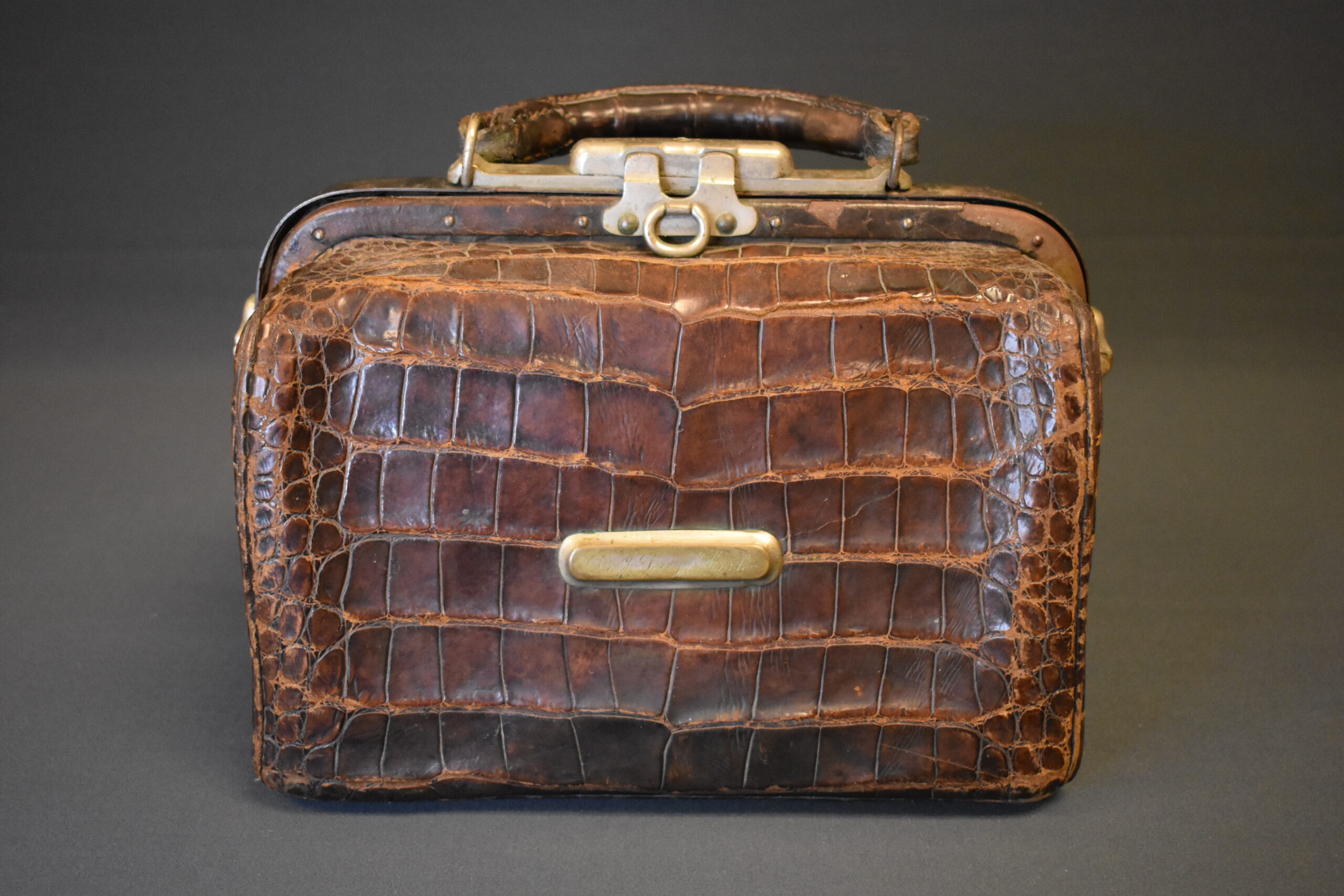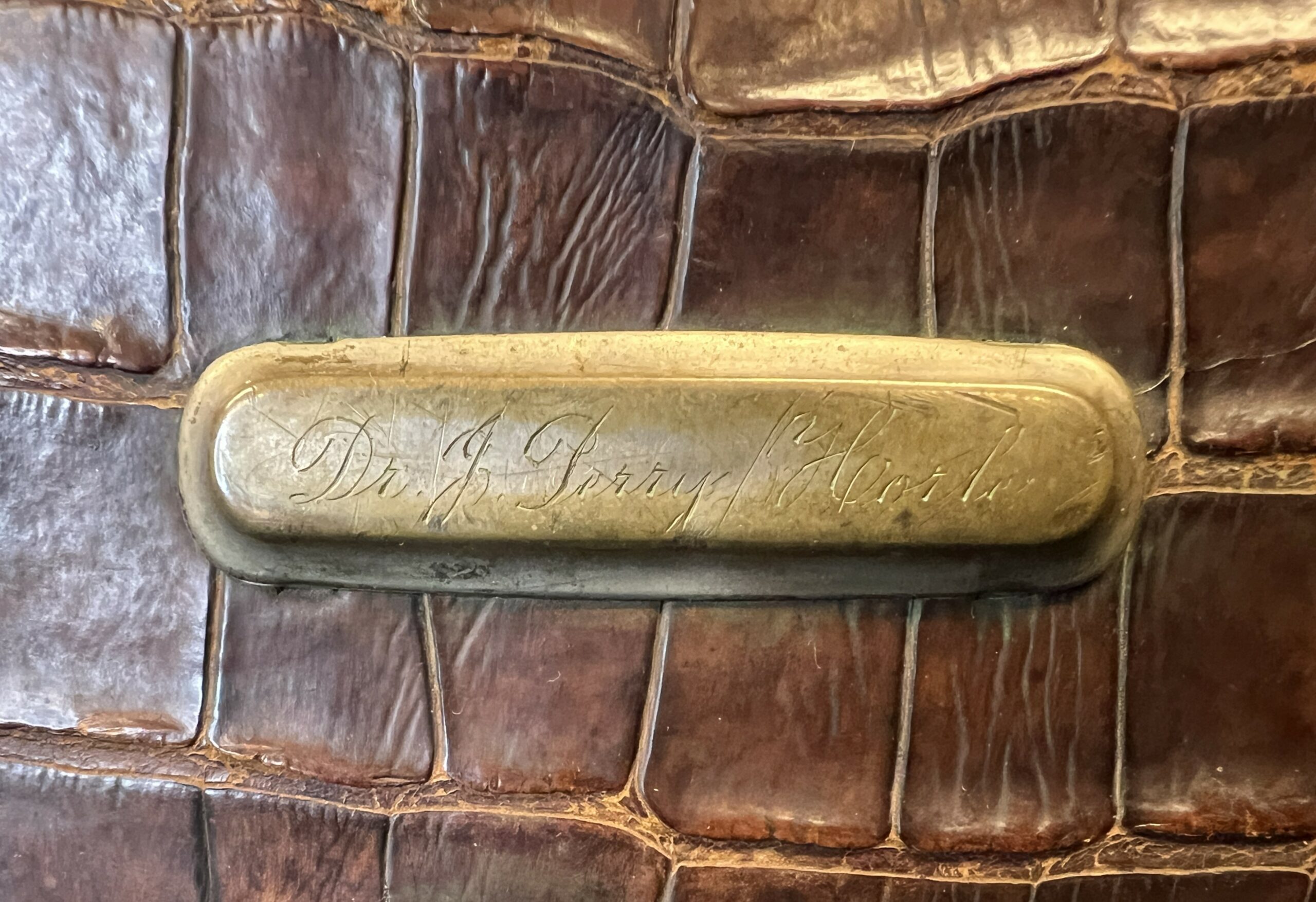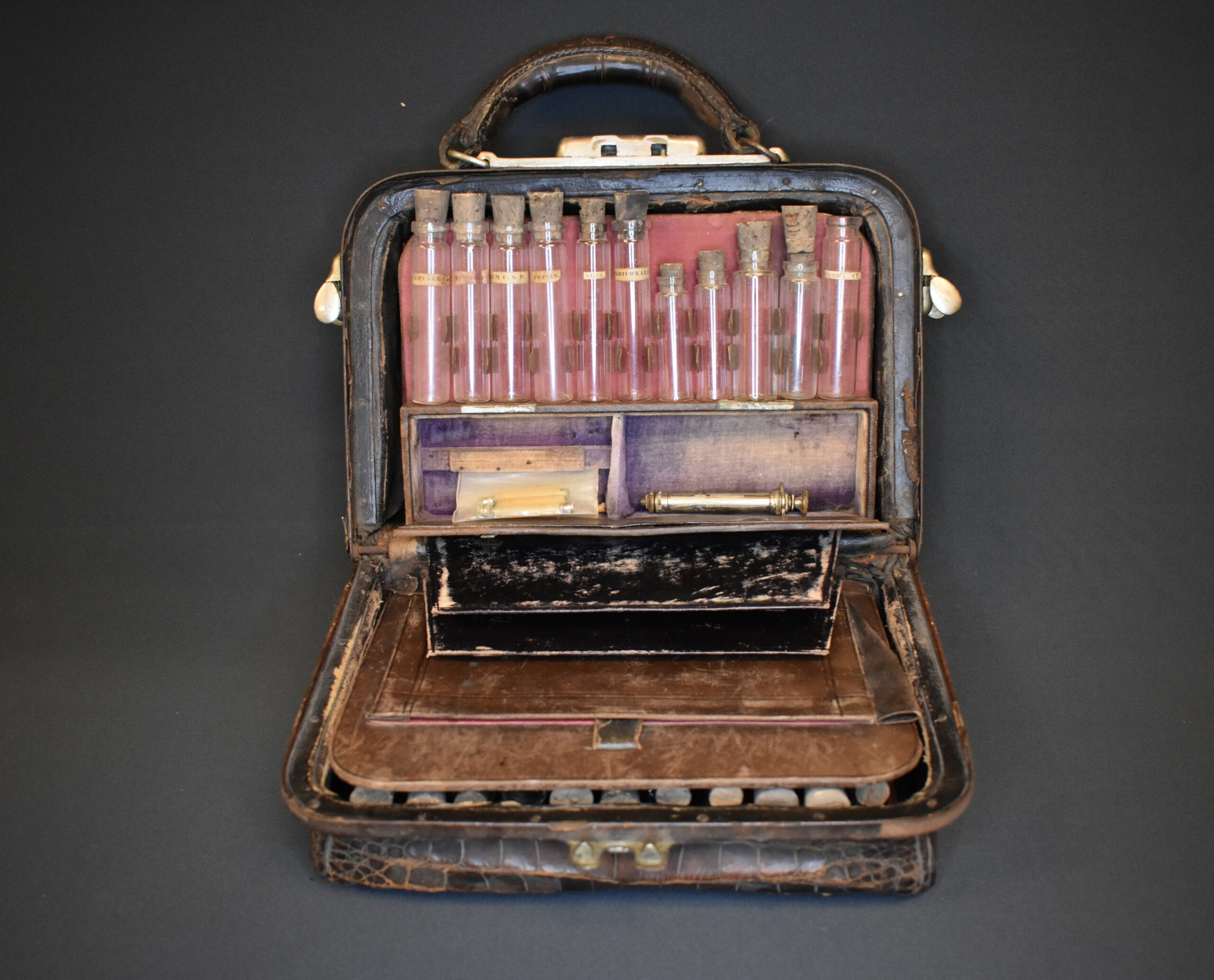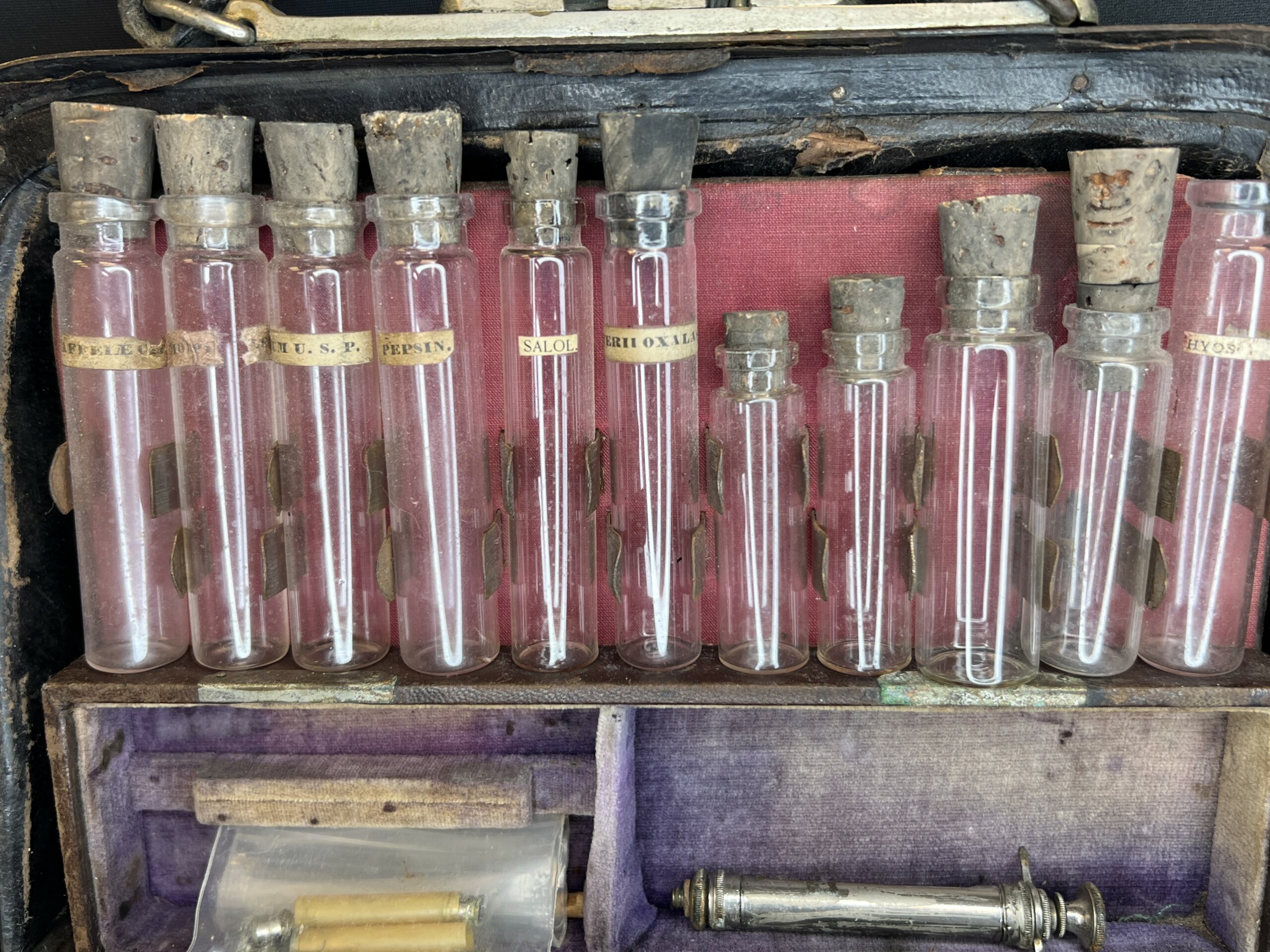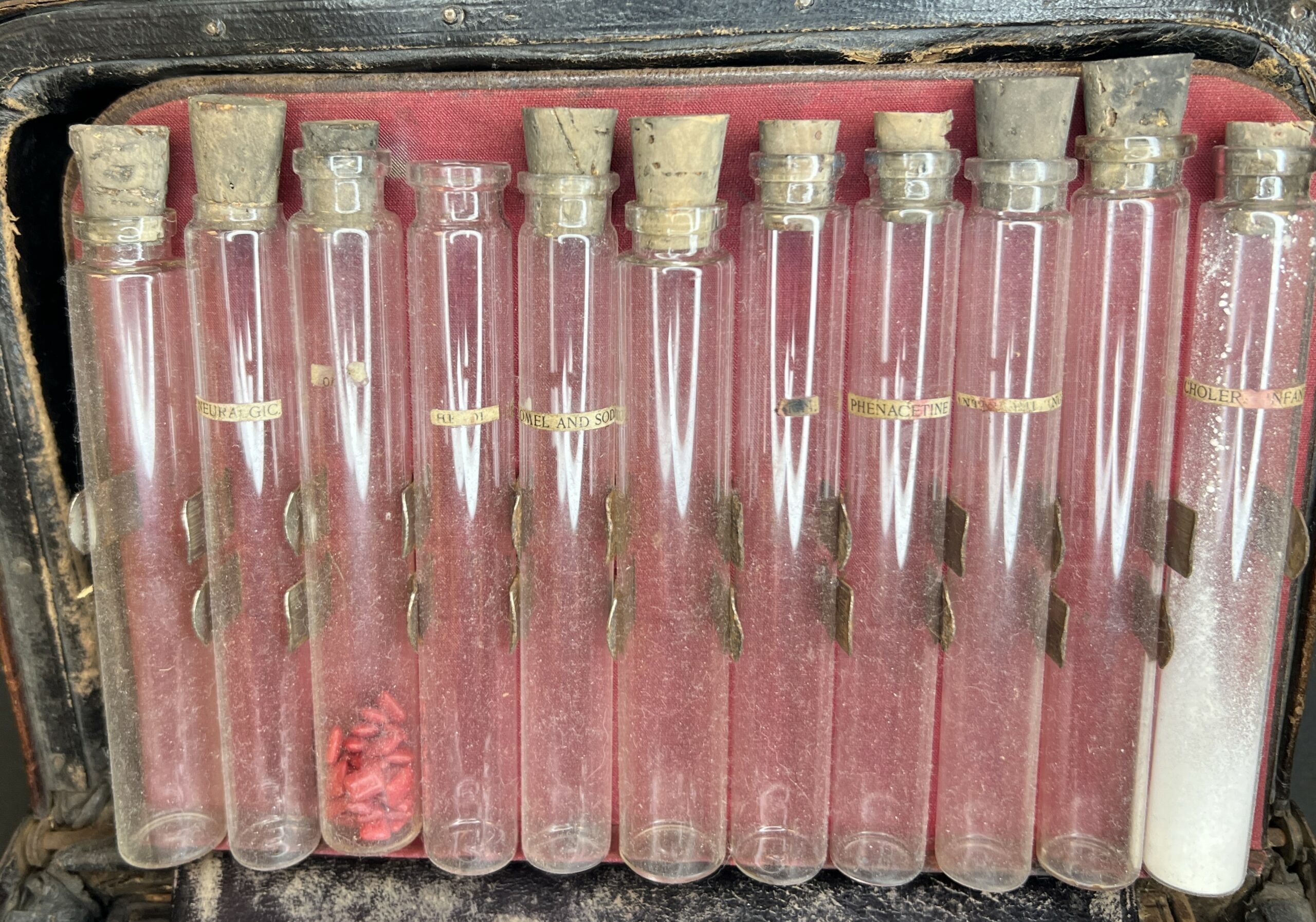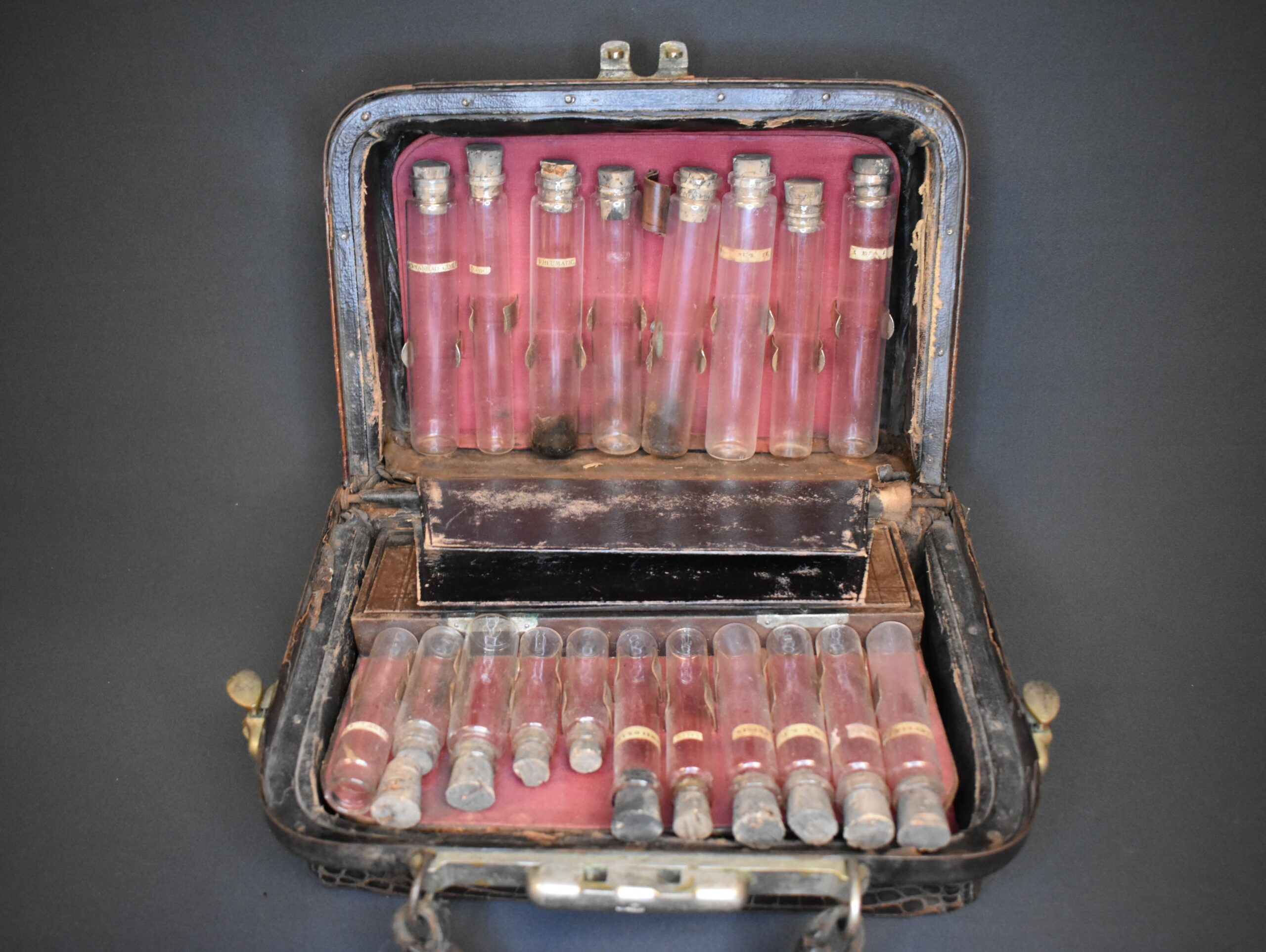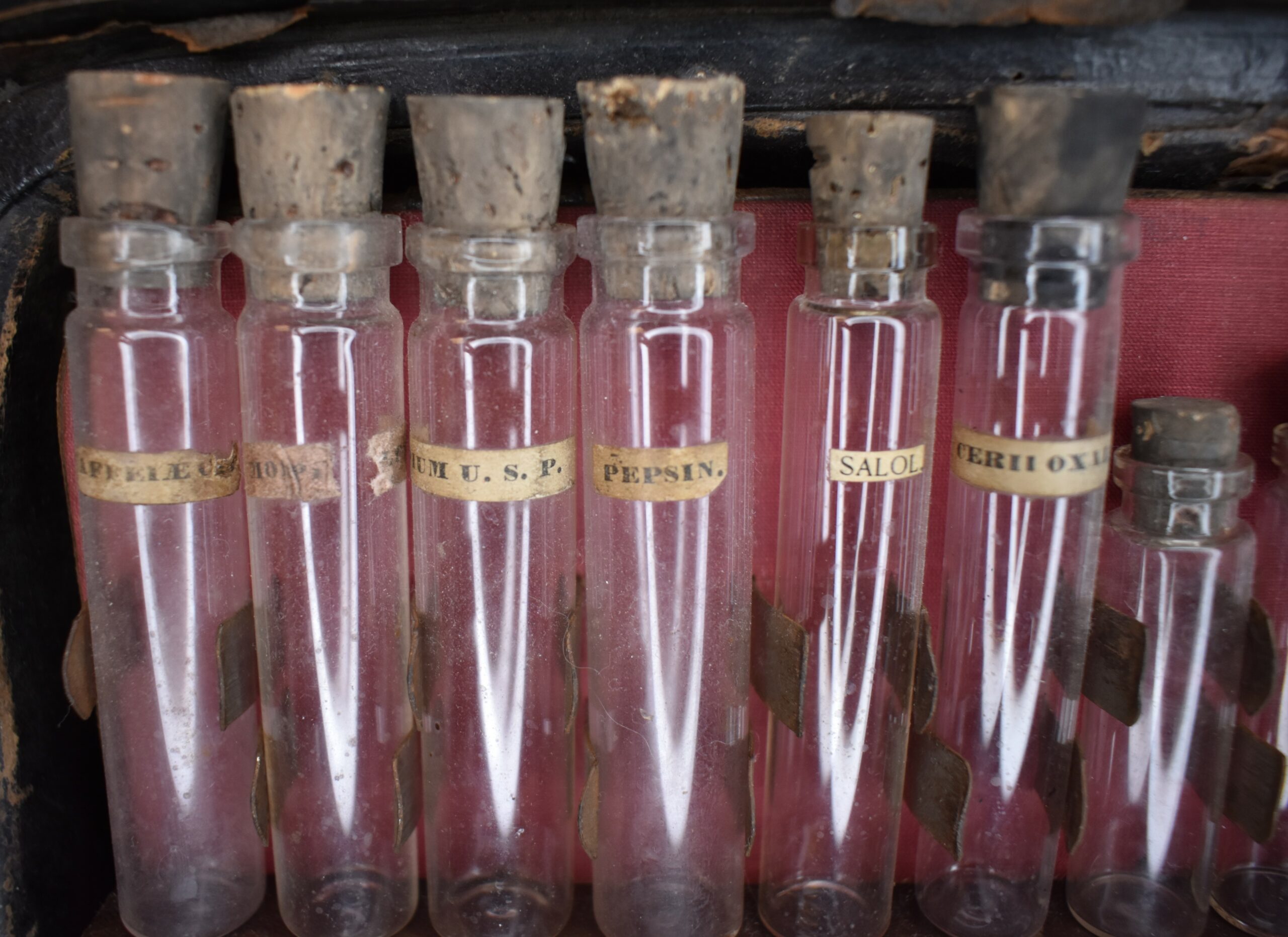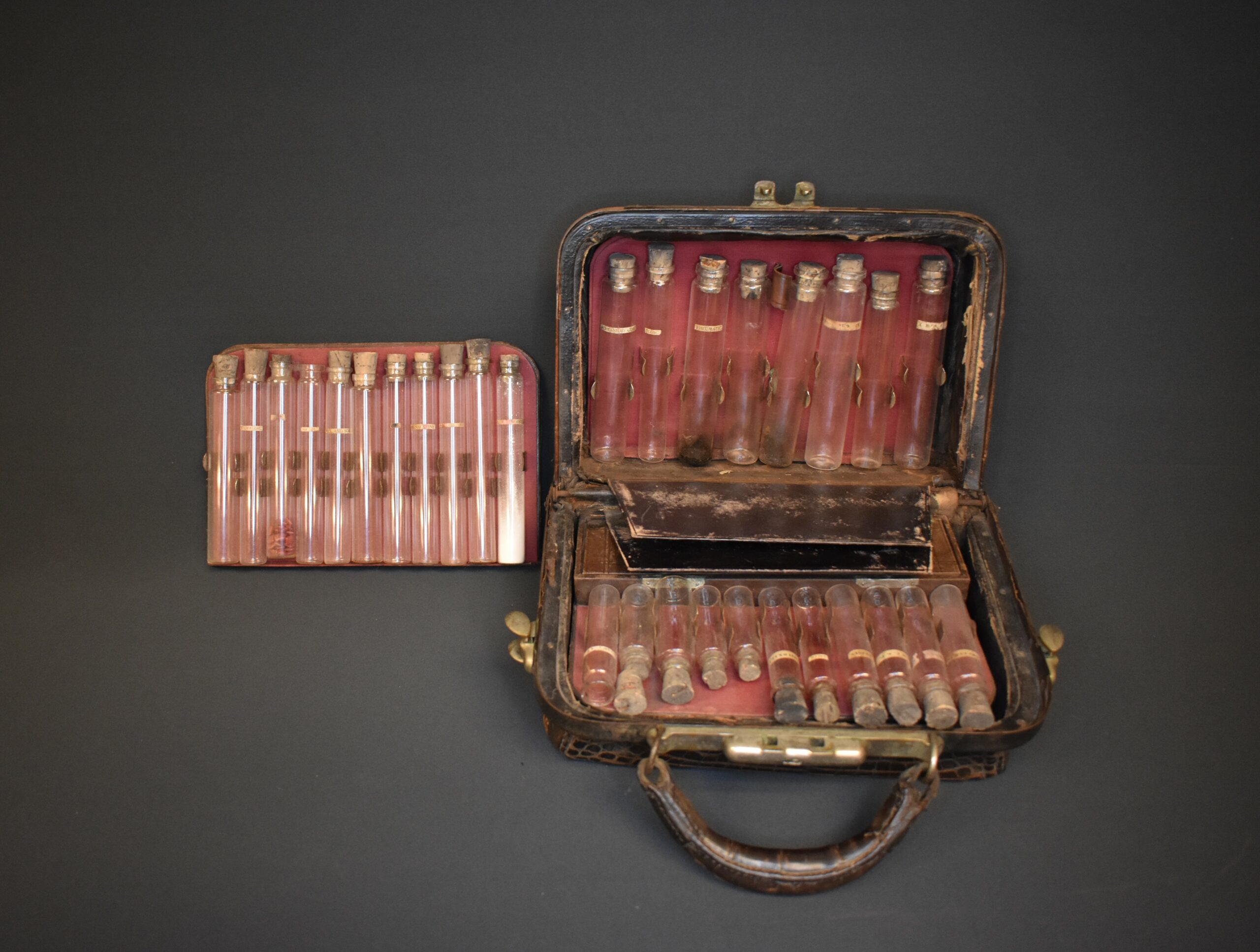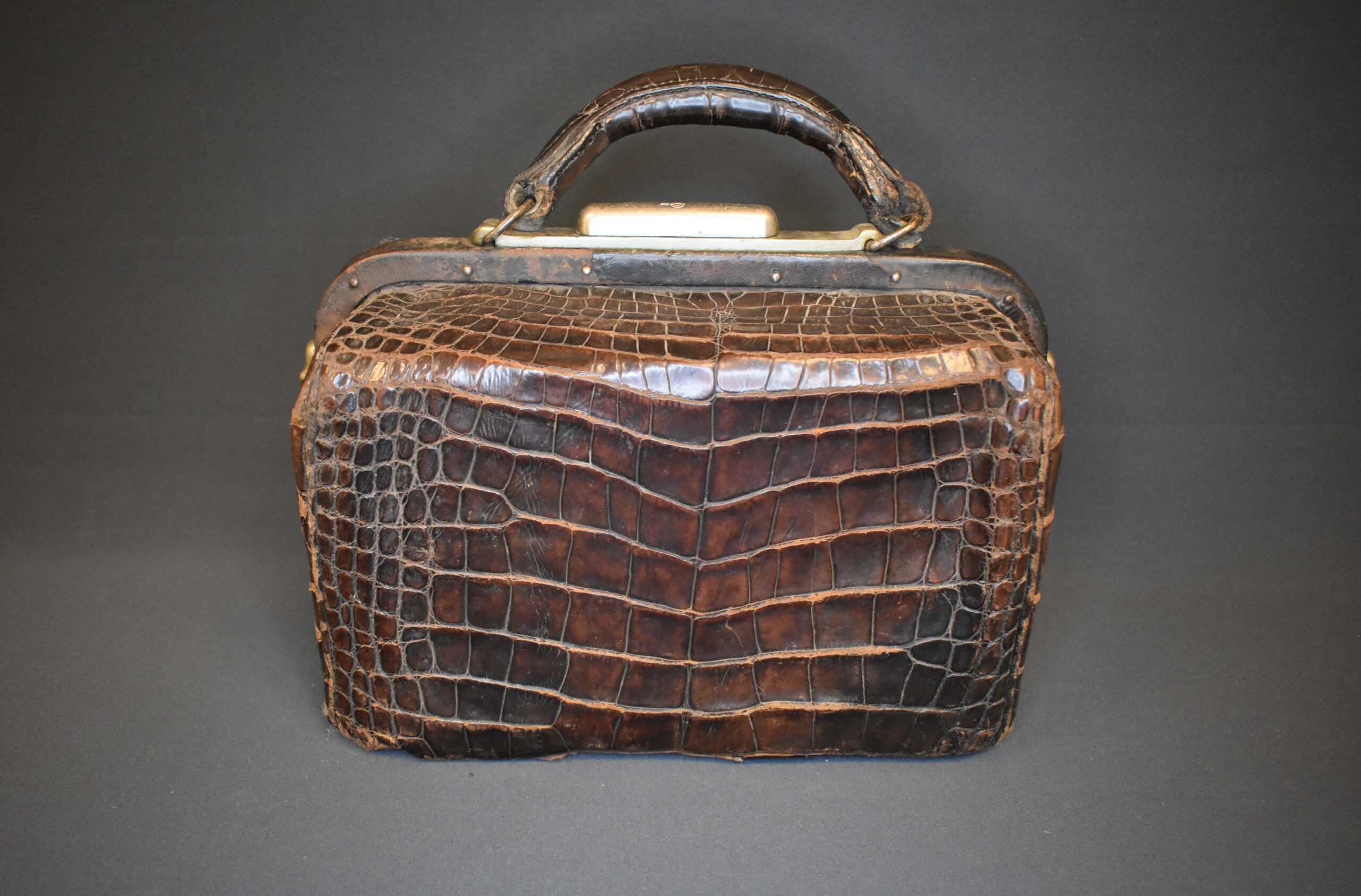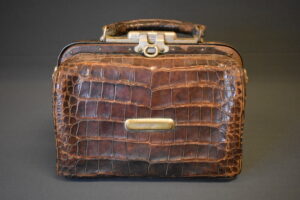
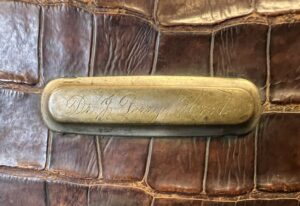
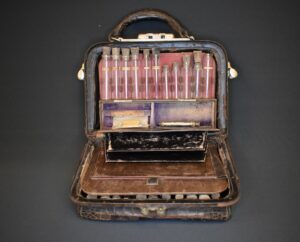

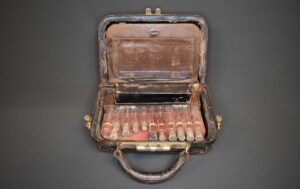
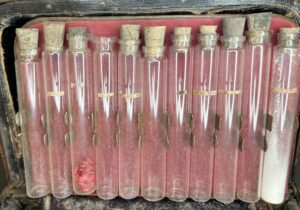
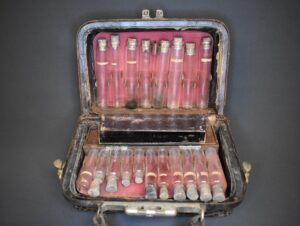
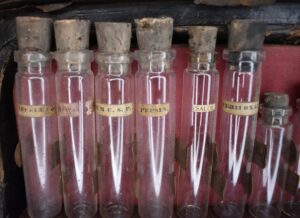
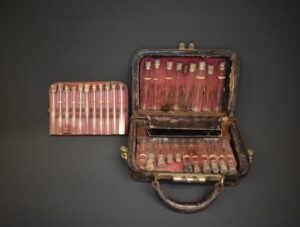
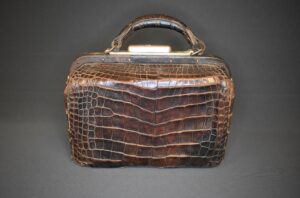
Medical Bag of Dr. John Perry Horle, Late 19th c. 1999.55.1
An alligator skin doctor’s bag. The bag has latches made of brass and a carry handle also in alligator. There is a brass plate on the front that is inscribed “Dr. J. Perry Horle.” The inside of the case has several compartments. One side has a removeable insert that holds eleven glass vials with corks and identified by paper labels. The back of the insert is covered in brown leather and has a pocket for papers and such. Behind this insert is space for an additional eight vials. On the other side of the case is space for eleven more vials. Underneath the vials is a compartment with a door made of brown leather and lined with purple velvet. Inside is a brass syringe and parts of a syringe.
Dr. John Perry Horle was born on August 9, 1868, to John Horle and Fidelia Palmer in Lenox, New York. He was the second oldest of two children and grew up in a farming family. He attended the Syracuse University College of Medicine and received his degree in 1894. In 1895 Horle married Mary Ella “May” Crumb, daughter of Dr. Dewitt Crumb, in Syracuse, New York. After their marriage they settled for a short time in Cato, New York, before permanently moving to Fly Creek, New York, in 1904, where he practiced medicine in the surrounding area. They had no children. Dr. Perry Horle, like many physicians of the time, spent time making house calls, being called to emergencies, and examining and determining cause of death in some of those cases. He is cited in numerous articles as having been called to sit vigil with patients or to render aid to those who needed it. He also served on the staff of the Mary Imogene Bassett Hospital and, “Dr. Horle was one of the area medical men who was responsible for the beginning of Bassett Hospital”1 in Cooperstown, New York. Dr. Horle passed away of cancer in 1927 at the age of 59. Mrs. Horle never remarried and died in 1961.
Dr. Horle practiced a type of medicine called allopathy, which evolved into today’s modern medicine, or what is also known as mainstream medicine. During most of the 19th century homoeopathy was the dominate medical discipline in the United States. One of the major principles of homeopathy was “like cancels like”. For instance, if one had a stomachache, they would give a substance known to cause stomach aches. They also believed that by giving minute doses of medicinal agents it would allow the body to heal itself. “By the late 1800s, there was seemingly an infinite number of homeopathic tonics, pills, and remedies concocted by homeopathic practitioners, who believed that medication should be taken to help the body rejuvenate itself.”2
Allopathy, sometimes called heroic medicine, relied more on providing the patient with remedies that would cause an opposite effect than the symptoms they currently had. For instance, if a person had a stomachache, the opposite effect would be to have no stomachache. They did not follow the “like cancels like” philosophy of medication. Practitioners of homeopathy and allopathy were quite vocal in their complaints about each other. Homeopathic doctors claimed that the high doses practitioners of allopathic medicine gave their patients actually caused more diseases than they originally had. “The homoeopaths criticized the frequent use of mercury and quinine by ‘allopathic’ physicians…practitioners argued that extensive use of the two drugs was dangerous since they produced various different diseases in the body.”3 Quinine we know is still used today to treat malaria, but we now understand that mercury is quite dangerous. However, homeopaths also used medication we now know to be dangerous such as arsenic and opium. Many doctors of all disciplines used substances such as cocaine, heroin, opium, arsenic, strychnine, mercury, and of course high volumes of alcohol, in medications for both adults and children. One advertisement from the late 19th century markets cocaine tooth drops for babies and children.
This particular bag was purchased from another living history village that had closed its doors. The bag was then sent to the Williamstown Art Conservation Center for cleaning and maintenance. Noticing that the vials still contained substances, they sent them to Williams College for analysis. They did indeed contain drugs that are either dangerous or controlled today. They found hazardous substances such as mercury as well as controlled substances like opioids, strychnine, digitalis, morphine, and atropine. One of the vials was labeled quinine as well. The contents of the vials had to be disposed of in the college’s hazardous waste facility as well as the DEA licensed Neuroscience department. Around the beginning of the 20th century allopathy had become the dominant medical practice although homeopathic practitioners and remedies are still popular with some today.
- “Mrs. Horle, Long-Time Resident Celebrates Birthday,” Historical Newspapers from 1700s-2000s – Newspapers.com, accessed March 31, 2024, https://www.newspapers.com/image/47317855/. ↩︎
- Stephen Logsdon, “The Rise and Fall of Homeopathic Medicine in the US, and Its Continued Popularity Today,” Becker Medical Library, November 5, 2021, https://becker.wustl.edu/news/the-rise-and-fall-of-homeopathic-medicine-in-the-us-and-its-continued-popularity-today/. ↩︎
- Shinjini Das, “Debating Scientific Medicine: Homoeopathy and Allopathy in Late Nineteenth-Century Medical Print in Bengal,” Medical History, October 2012, https://www.ncbi.nlm.nih.gov/pmc/articles/PMC3483755/. ↩︎
